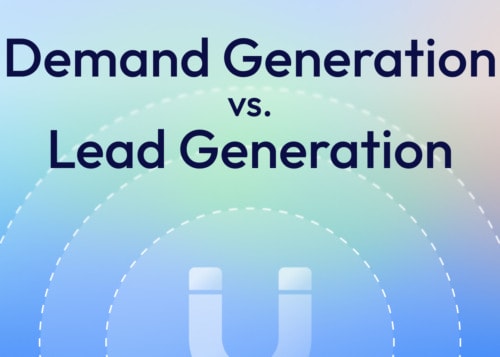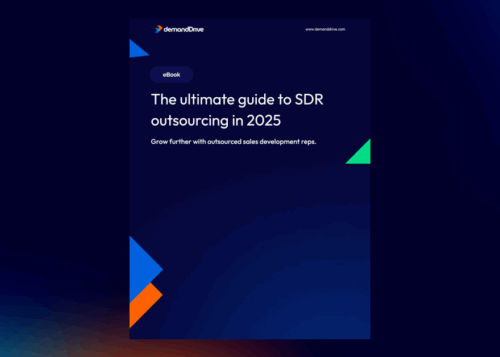Alignment and ABM

Why Paul Slack, Founder & CEO at Vende Digital, continues to beat the sales and marketing alignment drum. Plus, how true ABM can solve a majority of your alignment problems.
Our Guest
Name: Paul Slack
What He Does: A former tech sales rep who survived the internet boom in the 90s and early 2000s, Paul has taken that experience and turned his lens to the digital marketing side of things. He’s currently the Founder & CEO of Vende Digital.
Company: Vende Digital
How to Connect: Paul’s LinkedIn
Episode Summary
Stop us if you’ve heard this before:
“Following up on marketing leads is a waste of time – they’re all garbage!”
Or
“Sales reps are so lazy! We generated hundreds of leads and they aren’t even bothering to work them.”
It’s a tale as old as time. Well, a tale that’s at least 20 years old.
And unfortunately, the chasm between the two teams doesn’t seem to be shrinking. And in some cases, it’s growing wider.
Let’s lead with the punchline here – we have to get this right now more than ever.
And our guest, Paul Slack, has an answer.
A former tech sales rep in the 90s turned digital marketing expert, Paul has both the experience and knowledge to bridge the gap between sales and marketing teams.
His solution: ABM.
We talked with Paul about why sales and marketing are still misaligned, how ABM is helping solve that issue, and what the future of demand generation will look like.
The Questions
- Why are sales and marketing still misaligned? It’s been over 20 years – is this even a fixable problem?
- How have the responsibilities of those departments shifted in the past 30 years? How do they coincide with buyer behavior?
- You believe ABM can be that bridge. In your own words, what is ABM?
- Who’s responsible for ABM? Does it fall on the shoulders of leadership? A single department?
- What does it look like when done correctly? What about when it’s done poorly? And how is that solving the misalignment issue we’re still seeing?
Top 3 Takeaways
Why Can’t We Get This Right?
🤬 “But these teams have always been ideally working towards the same goal, but doing it in different ways. And it’s a problem that existed 20 years ago. It’s a problem that existed 10 years ago. It’s a problem that still exists today. Why can’t we get this right?”
Rocky Balboa and Apollo Creed. The Boston Red Sox and the New York Yankees. Sales and Marketing.
Ok, maybe it’s not an iconic rivalry, but the bad blood between these two teams is no joke. And it’s not a recent issue either – Paul talks about the relationship between these teams from his time as a sales rep in the 90s. Spoiler alert – it wasn’t great.
- Part of it can be attributed to the historical burden on sales to create demand.
- Part of it can be attributed to the perception of marketing as the “make it pretty” department.
- Part of it can be attributed to the rise of inbound marketing and a shift to quantity over quality.
Whatever started the rift doesn’t matter. What matters now is the need for teams to join forces and create a journey that buyers want to take because guess what – buyer behavior has also changed dramatically over the past 20 years.
🎙️ We’ve talked about alignment a few times in the past. Check out some of our other content for more alignment tactics:
🥒 Building Sales & Marketing Alignment
🦈 Marketers Are Friends, Not Food
💪 The Power of Empowering Your SDRs
The ‘Aha’ Moment
💡 “So if you think about it, marketing’s job is to do everything to educate the buyer up to that moment. And then the minute that buyer has that aha moment and goes, ‘I wonder how this is gonna work in my environment,’ they need to talk to a salesperson because that question cannot be answered on a website.”
That “Aha!” moment is the key to having sales and marketing play nice. And realizing that was what pushed Paul into digital marketing in the first place.
When a buyer has consumed content on your product or solution and they’ve reached the education threshold (where consuming more won’t answer their specific questions), it’s time for sales to shine. But sales often wants to save the meaty and high-value content (slide decks, case studies, proofs of concept) for the discovery & demo phase.
Paul’s suggestion is to take that content and un-gate it, allowing the buyer to continue their education at a pace that makes sense for them. He’d rather pump out as much educational information as possible and optimize sales targeting for hand-raisers and browsers.
Let marketing be responsible for education and let sales be responsible for context. Then they have to work together to deliver a quality buyer’s journey.
What Even Is ABM?
🎓 “What is ABM? It’s aligning your business, your content, and your actions around educating and engaging with a targeted group of stakeholders throughout their entire buyer journey.”
Continuing the idea from above, true ABM is about alignment.
It’s not about generating hundreds of MQLs a month and tossing them to sales for further qualification. It’s about moving targeted stakeholders through their buying journey.
That means sales and marketing need to come together to build:
- Target accounts
- Messaging
- Content to support outreach
- Processes to relay intent signals
- A demand generation strategy
The goal with ABM isn’t to just capture the demand of in-market accounts, it’s to create and sustain demand with accounts that aren’t in-market yet. That way, when those accounts are in-market, a large percentage of them will go to you.
Our Favorite Quotes
💯 “If they’ve got three or four other vendors in their head and you’re one of the lucky three or four…and the other vendors are adding roadblocks or making it really hard for them to get to the information that they want. And you’re the one that’s optimized to make it easy for them. And you are the easy button for them getting this across the finish line. You’re gonna win that, you’re gonna be that 100% that wins the business.”
This goes back to the idea that sales shouldn’t hold high-value content hostage from potential buyers. The easier you can make it for buyers to learn more about your solution, how you help companies, and what a good future-state looks like, the better.
That’s only possible if both sales and marketing know their roles and work together.
You can’t be the “easy button” for buyers if you have infighting amongst your teams.
🏆 “The companies that figure that out, that marketing’s job is to create demand, and sales job is to create context and help deals get across the finish line, are the ones that are going to win in the future. And the ones that continue to fight sales and marketing alignment are the ones that are going to be left behind.”
Just a good summation of the big picture here.
Misaligned teams will continue to fall behind as buyer behavior trends towards a more “self-driving” experience.
With marketing focused on demand creation & capture and sales focused on context, the two teams need to work together to make the journey for buyers as frictionless as possible.
We worked with Paul on a separate event that covered the role of sales development in an ABM strategy. For that event we created this graphic 👇

Marketing needs to surround your buyers with educational content that pushes them to that “aha” moment.
Sales needs to deliver relevant and timely context based on the content your buyers are consuming.
And they need to do it together. Otherwise, the whole process becomes a disjointed mess.
Final Thoughts
Hey there! AJ here 👋
It’s been a while since we talked about ABM.
Back in 2017, we worked on an industry report with our friends at Scratch Marketing + Media. At the time, a lot of our findings were eerily similar to what we talked about with Paul in 2023.
In 2017, ABM was about:
- Delivering personalized experiences for each account on your target list
- Aligning sales and marketing over which accounts to target
- Getting ongoing intel on those target accounts
- Determining the optimal content to share
All of that led us to this definition:
“[ABM is] carefully choreographed Sales and Marketing activities aligned around penetrating the accounts that matter most to your business.”
in 2023, that definition still rings true.
And in 2023, people like Paul are still beating the alignment and ABM drum.
Because for some reason, companies still haven’t figured this out. Sales and marketing butt heads ➡️ buyers get a disjointed journey ➡️ your pipeline stagnates.
But when everyone works together, everyone wins.
Related Resources
Continue exploring

Alignment Led Growth

The real ROI of SDR outsourcing: How outsourced SDR companies help drive growth

Demand generation vs. lead generation: Why “lead dumps” no longer work

Modernize your B2B content syndication strategy

The future of sales enablement: AI, GTM & human-centered growth

The ultimate guide to SDR outsourcing in 2025



